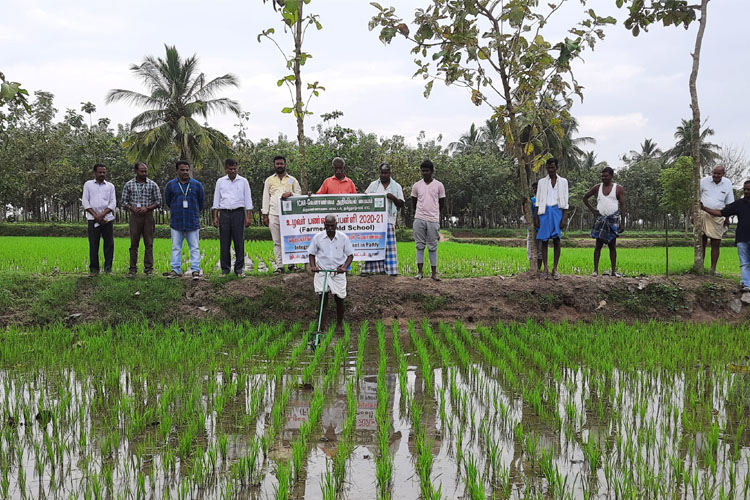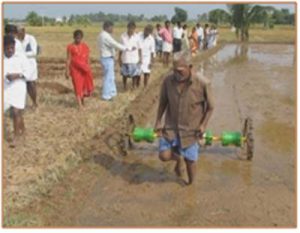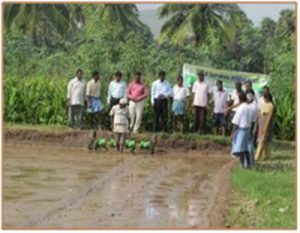Direct sowing using Drum Seeder in paddy – A success in Thiruvannamalai district
Paddy is the major staple food crop in Thiruvannamalai district of Tamil Nadu State covering 1,12,013 hectares of area. Paddy is more suited to high rainfall regions because the crop requires abundant moisture level either through rainfall or irrigation to keep the soil under saturation throughout its life period. Water is the most critical input in order to assure the production of good quality and yield. However the recent practices of System of Rice Intensification (SRI), direct sowing and trials of drip irrigation system on paddy drastically reduced the amount of water required for its cultivation.

Demonstration on cono weeding in Paddy

Demonstration on drum seeding in Paddy

Farm advisory service in drum seeding
Mechanization in Paddy cultivation can be possible at every stage of the crop i.e from land leveling to harvesting of the crop. The various implements were used to cultivate the paddy are laser leveler, Puddlers, Paddy Drum Seeder, Cono weeder, paddy thresher cum harvester, etc. In Thiruvannamalai district the paddy growers are intensively using the above said implements with the subsidies from agriculture and allied departments for the past five years.
Among the implements the Paddy Drum Seeder play a vital role in bringing the true mechanization in paddy cultivation. The performance of the drum seeder is mainly depends on the type of soil and field conditions, preparation of seed beds, speed of operation and power source.
Introduction of Paddy Drum seeder
A low cost and manually operated KSNM Direct Paddy Seeder was developed and certified by Tamilnadu Agriculture University, Coimbatore, India was introduced to Kaliyur village paddy growers during Kharif 2012 7 kharif 2013 by the KVK, Thiruvannamali as On Farm Testing (OFT) and Front line Demonstration (FLD).
The KSNM direct paddy seeder covers 8 rows of 20 cm row to row spacing at a time. This implement ensures uniform plant population throughout the field. This hyperboloid shaped drum with 200 mm diameter, 9 numbers of seed metering holes of 9 mm hole diameter. Baffles are provided inside the drum between seed holes resulting in uniformity of seed rate throughout the operation. These baffles also ensure hill dropping of seeds. Each seed drum has two rows of planting. Wheels are provided at both ends made up of plastic material to provide floating characteristics. The wheel diameter is 2 feet.
Materials Methods
The study for evaluating the performance of paddy drum seeder was undertaken at Kaliyur village of Cheyyar taluk in Thiruvannamali district of Tamilnadu. About 125 acres have been taken to analyze the yield level and labour cost for cost of cultivation been designed in the different programmes of the KVK. The selection of farmers has been made through different group meetings, discussions with farmers club and training programmes conducted at the village level. The KVK execution to the paddy drum seeder was treated as On Farm testing’s and front Line Demonstrations for two years i.e Kharif 2012 and Kharif 2013. Following basic information were considered to execute the experiment.
- Paddy variety : ADT 43, ADT 45
- Soil type : Clay Loamy Soil
- Irrigation Source : Bore well
Treatments
- T3 : Mechanization in paddy Experiment with paddy Drum Seeder
- T2 : Ordinary Transplanting Method of Cultivation
- T1 : Traditional farmers Practice
Land Preparation
- Direct Seeding avoids the nursery raising, pulling of seedlings and transplanting at the field.
- Levelling of the land and proper drainage facility are the most important things in the method of operation.
- Lazer levelling can be done with the help of lazer leveller
- Puddling was carried out with the help of tractor drawn puddler or rotavator in 5-10 cm water level
Paddy Seed Treatment
The seeds were wetted with 0.1% carbendazim solution about 24 hours. A gunny bag in which the required quantity was soaked with water and the seeds were spreaded in the gunny bags and left for one day to improve the uniform sprouting has to be maintained. Then dry the seeds in open air to maintain the moisture level is important before filling the seeds in the drum seeder.
Sowing seeds with Drum Seeder
A thin film of water over the main filed was maintained at the time of sowing is essential. The sprouted seeds were filled in all drums up to 2/3rd of its capacity. The Ground wheels make the impression to serve as a marker for next pass and helps for good movement of seeder. Continuous watch should be taken at the holes and cover the drum because of blockage of seeds due to high speed of operation which results in low germination.
INM and IPM Practices
The NPK dose recommended for paddy is 120:60:60 and the nitrogen was applied in two splits. To reduce the pest and diseases cultural practice along with chemical sprays were recommended to the farmers.
Conclusion
- Among the opinions from farmers stated that the sowing with Paddy Drum Seeder showed the huge amount of labour savings been achieved in raising the nursery, transplanting, etc., the labour required for transplant paddy seedlings is 2 against 30 Numbers in traditional method of cultivation.
- The method proved one of the most important costs saving technology in Cheyyar block by reducing the required quantity of seeds to the minimum. The average seed cost (12.5 kg) involving in drum seeder is about Rs.480.00 against 30 kg of seed worth of Rs. 1800.00 in the traditional method of cultivation.
- The crop duration reduced by 6-7 days when compared to the traditional cultivation methods.
- The cost of cultivation was also reduced by 20% and the net income increased by 30%
- It is the effective method of cultivating paddy during drought periods as it required less quantity of water when compare to normal cultivation practices. It requires only four hours for transplanting and saving the time in nursery preparation, transplanting and weeding works. The method minimizes the weed growth as thin layer of water always persisting in the main field.
- At present, the direct sowing of paddy technology has spread over an area of 125 acres in Thiruvannamalai district.
